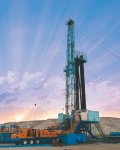Geology
The Post Salt Сomplex of the Precaspian Basin is the Future of Kazakhstan❜s Oil
#5 (149), November 2024
A new stage in the study of the salt-dome part of the Precaspian Basin is associated with the widespread use of 3D seismic exploration. The prospectivity of deep horizons of the postsalt complex are determined by the capacity of the traps; being on the paths of hydrocarbon migration from the sub-salt source to the upper horizons, the traps inevitably had to be filled with migrating hydrocarbons.
Current Technologies Used for Data Acquisition in Drilling
#4 (148), September 2024
As is known, oil and gas reservoirs vary by trap type, reservoir, rock formation, migration type, and cap rock. Based on this data, geologists determine the area of the territory, the thickness of the prospective reservoir rock, the expected porosity of the rock, the type of hydrocarbons present in the trap, and so on. The data for such reservoir assessments are obtained through well logging and subsequent interpretation.
Conformity of Oil and Gas Content Advancement within the Western Part of the Turan Platform
#2 (104), April 2017 special issue
In accordance with the characteristics of the regional tectonic position, the western part of the Turan platform is presented by the North Ustyurt (the same name system of bending and upheaval), Bozashinskiy upheaval and the surrounding areas of Mangyshlak and Prikarabogazya
Increased Oil Recovery Ratio of Viscous Crude Oils
#1 (103), February 2017
The article presents rationale of the possibility to increase the basic parameter of parameter field development – the factor of oil recovery from reservoirs designed and exhausted (suspended) deposits with use of new developments and advances in technology.
It is appropriate in this period, as the developed fields run out of normal "light" crude oil at the backdrop of declining reserves replacement level due to new discoveries of medium and light crude oils.
Increased oil recovery ratio of viscous crude oils
#6 (102), December 2016 special issue
The article presents rationale of the possibility to increase the basic parameter of parameter field development – the factor of oil recovery from reservoirs designed and exhausted (suspended) deposits with use of new developments and advances in technology.
It is appropriate in this period, as the developed fields run out of normal "light" crude oil at the backdrop of declining reserves replacement level due to new discoveries of medium and light crude oils.
Recovery of residual oil from mature fields
#3 (93), June 2015 special issue
The article presents rationale project on redevelopment of mature suspended fields Shubarkudyk and Zhaksymai, and recovery of difficult to recover residual oil.
Depletion of medium and light oil reserves makes oil industry pay more and more attention to commercial development of heavy, high viscosity oil difficult to recover. Production, processing and transportation of such oil involve difficulties and sometimes become impossible due to its low mobility caused by high viscosity.
Ustyurt – real testing area to discover cluster of oil, gas and condensate fiel
#4 (88), September 2014
The article presents an industrial innovative project in which implementation of the new trend in exploration (including seismic investigations) and drilling works at Tasoyuk subsoil area is offered for the purpose of enhancing the possibility to discover natural gas and treat it with due quality. That means putting intellect, knowledge and understanding into hydrocarbon accumulations’ search, exploration and development.
Karachaganak: Path to Success
#5 (83), October 2013 special issue
More than fifteen years ago, primary goal of Karachaganak Petroleum Operating b.v. (KPO) was to increase production to a completely new level. Together partners have applied industry leading hydrocarbon technology to one of the world’s most complex reservoirs.
Underground Natural Resources. Prospects of oil and gas content of the Caspian Sea shelf
#4 (70), October 2011 special issue
Fifteen sedimentary basins have been allocated in the territory of Kazakhstan: Pre-Caspian, Ustyurt-Buzashi, Mangyshlak, Aral, Syr-Darya, North Torgai, South Torgai, North Kazakhstan, Teniz, Shu-Sarysu, Ili, Balkhash, Alakol, Zaisan and Priirtysh. The total forecasted recoverable resources of hydrocarbon raw materials within these basins are estimated at 17 billion tons, of them 8 billion tons fall on the Kazakhstan sector of the Caspian Sea. More than 250 hydrocarbon fields were explored in the area of the main basins of oil and gas production (Pre-Caspian, South Mangyshlak, Ustyurt-Buzashi, South Torgai and Shu-Sarysu).
| © ТОО Издательский дом PETROLEUM. 2000 - 2025 Республика Казахстан 050000 г.Алматы ул. Наурызбай батыра, 58, офис 12 Тел: +7 (727) 258-28-38 Факс: +7 (727) 250-50-82 https://www.petroleumjournal.kz/ | .Без письменного разрешения редакции перепечатка материалов Petroleum не допускается. При использовании материалов активная ссылка на PETROLEUM обязательна. Журнал перерегистрирован в Министерстве информации Республики Казахстан 14 октября 2003 года. Регистрационное свидетельство № 4310–Ж. |
